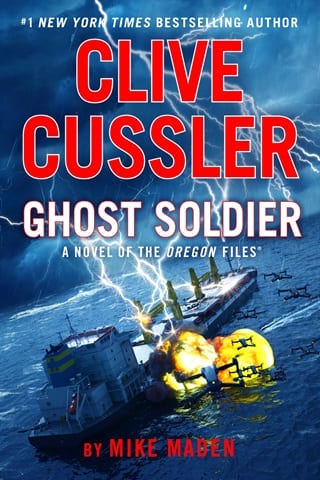Chapter 20
20
Since there was no way to determine the plane’s destination, Cabrillo had to figure out another way to track it. He remembered the small GPS targeting beacons he was planting at the Afghan ammo dumps with his boot.
He pressed his boot heel into the deck and applied enough pressure for it to release the next tracker. He bent down to pick it up so he could hide it somewhere—but there wasn’t one. The depositing mechanism must have jammed. He tried again. Nothing. Either the mechanism was failing to deploy the trackers or he had accidentally deployed several trackers at a time. The delivery device was effective but imprecise. He couldn’t just leave his boot behind. Even if there were still trackers stuck in the mechanism, they only activated after they were deployed.
What were his other options?
He knew the Oregon’s radar was tracking the plane now, but its range was limited. There was only one last possibility.
After pocketing his phone, Cabrillo dropped his trousers.
He snicked open the switchblade and gritted his teeth as he began to slit open the sensitive skin on his hip. But at that moment the plane hit a pocket of turbulence, driving the blade deeper than Juan intended. Blood spurted over the knife as Cabrillo dug out his personal Oregon tracker. His blood-slicked fingers nearly dropped the miniature device before he pocketed it.
He then cut a piece of his shirt off for a bandage and jammed it into the bleeding wound before pulling up his pants and cinching the belt tightly to hold the bandage in place.
He wiped his bloody hand against his shirt and pulled his sat phone back out of his pocket.
“Max, the satellite still reading my tracker?”
“Like NORAD tracking Santa’s sleigh on Christmas Eve.”
“Good. Keep it locked. I’m planting my tracker on the plane so we can keep eyes on.”
“You pulled your tracker? Ouch. What’s next?”
“The plane is all automated. Lemme think about it. Don’t go anywhere.”
“Standing by.”
Juan killed the call. He spied a nook on the bulkhead behind a junction box and secured his tracker there, careful to wipe away any traces of blood he smeared on the panel.
Now he had to find a way to get off the plane.
He began searching for anything that looked like a storage locker where he might find an emergency parachute. Ten minutes later he gave up the search, his headache still pounding on his skull like a rendition of “Babalú” on a Cuban conga drum.
He leaned against a nearby pallet considering his dwindling options when suddenly the obvious solution hit him like, well, an angry Pashtun.
Juan examined the parachute deployment bag secured to the top of the pallet he had been leaning against. It was comprised of two parts. The first was a small drogue chute designed to catch the initial gusts of wind in a free fall. The opened drogue chute would then pull out and deploy a much larger cargo chute located inside of the deployment bag.
Juan snicked open his knife and cut away the straps holding the deployment bag and drogue chute. He looked around the compartment. He didn’t see any static lines.
Normally there would be static lines attached to the drogue chute, but he didn’t see one on his pallet or on any of the others. Those static lines would have been fixed to the aircraft so that when the pallet shot out the back, the static line would tug on the drogue chute and deploy it.
That meant these chutes were opened either by an altitude sensor or a timer. He examined the drogue chute and spotted the altitude sensor. He decided to remove it. He wasn’t going to risk his life on the possibility that the Vendor’s automated system could somehow force a malfunction of his unit. Better to rely on the old-fashioned method.
Juan then cut off several long pieces of the polyethylene cargo webbing securing the load to the pallet via buckles. Minutes later he pieced it all together with the deployment bag, heavy as sin owing to what was no doubt at least a half dozen fifty-foot-long suspension lines and a big cargo chute. He detached the drogue chute and gripped it tightly in one hand, careful not to let the drogue chute lines get tangled up with anything. After he leaped out of the plane he’d release the drogue and it would pull the bigger cargo chute out of his jerry-rigged pack.
He scanned the dissected ammo pallet with his engineer’s eye. He estimated it weighed at least four thousand pounds, maybe even five. That was twenty to twenty-five times his own lean muscular body weight of two hundred pounds. The cargo parachute was designed to carry the much heavier weight. Cabrillo knew the drogue chute couldn’t do the job for him, but he wasn’t sure if he weighed enough for the big chute to fully deploy its canopy.
Well, he’d find out soon enough.
Cabrillo secured the makeshift parachute rig to his back, cinching it tightly to his shoulders and around his thighs with the buckles that had secured the cargo straps to the pallet. The contraption wasn’t pretty and it sure as heck wasn’t going to feel good when that chute popped open and yanked him skyward, but it should do the trick.
He pulled his phone out and called Max.
“My Uber app isn’t working, so if you don’t mind, I could really use a ride.”
“You found a chute?”
“In a manner of speaking.”
“Air’s gonna be a bit thin at your altitude,” Max said. “And I hope you brought your long johns. Murphy estimates the ambient air temp is around twenty degrees.”
“I love a good cold plunge—even if it is at a hundred twenty miles per hour. Question: After I make the jump, how long will it take for you to reach me?”
“Eric’s calculating that,” Max said. There was silence on the other end for a few moments.
Eric’s voice finally chimed in. “At full speed, no more than thirty-seven minutes. Water temperature is around eighty-four degrees.”
“Practically a hot tub. I’ll see you in thirty-seven minutes then,” Juan said as he headed for the exit door.
 Fullepub
Fullepub 



